Amazing Animals
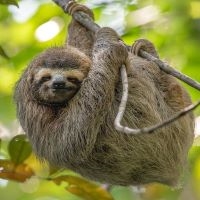 |
Sloth
Moving o-so slowly along tree branches, sloths travel an average of 4 metres per minute, 4.5 metres at a spurt, but spend 90% of their day either motionless or asleep. This avoids detection by predators such as jaguars, ocelots and eagles, and results in an algae, which itself hosts and sustains many insects, being able to grow on their fur which camouflages them.
Classified as two or three toed, all sloths have three toes on their back feet. The three toed sloth has extra vertebrae in its neck and can rotate its head almost all the way round. Descendants of large land sloths, the size of elephants, living 28 million years ago, sloths are related to armadillos and anteaters, and have adapted to living in trees, descending only once a week to defecate. Sloths eat, sleep and give birth hanging from branches. Cumbersome on land, they dig their claws in and drag themselves along, although they are surprisingly good swimmers and can further reduce their already slow metabolism to be able to hold their breath underwater for up to 40 minutes.
Mainly nocturnal and solitary, sloths only interact during the breeding season. The one baby will stay with mum for up to 5 months, learning what to eat by licking her lips. Sloths have multi-chambered stomachs and it can take up to a month to digest their leafy diet.
Found in the forests of Central and South America, four types of sloth are classified as ‘least concern’, the other two are the maned sloth, living in Brazilian rain forests which is ‘Vulnerable’, and the pygmy sloth, an island dweller that is ‘Critically Endangered’. Threats include loss of habitat and human encroachment, electrocution by power lines, pesticides, road traffic accidents, and poaching for the pet trade.
 |
Kakapo
The kakapo, a large, flightless parrot, indigenous to New Zealand, is one of the most endangered animals on earth. Solitary and nocturnal, adults meet only to mate. Males gather together in a lek to compete for females, displaying and calling, the female will choose the mate that puts on the best ‘show’. However, breeding only takes place when trees are at their most fruitful and there is enough food, which happens approximately every 2-4 years. Then, up to 3 eggs will be laid in tree hollows and incubated for 10 weeks.
Because they cannot fly, kakapo’s legs are very strong and they can climb trees right up into the canopy, using their short stumpy wings to ‘parachute’ back down.
Once New Zealand’s third most common bird, with no natural enemies, humans have been responsible for their near extinction. At any sign of danger, the kakapo freezes and relies on its mossy green feathers for camouflage; but when settlers introduced cats, stoats, ferrets, and rats, these predatory animals could sniff out kakapos, which have their own distinct odour; unable to escape, they became easy prey. Foraging females leave their nests unattended at night, so eggs and fledglings were also easily sniffed out.
There are fewer than 200 kakapos remaining, all protected on two islands off South New Zealand where breeding programmes are taking place. However, because numbers are so few, their genetic diversity is low, making them more vulnerable to disease. The kakapo is classified as Critically Endangered.
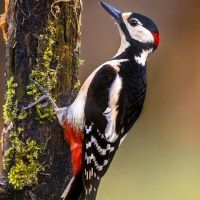 |
Woodpecker
The most commonly seen (and heard) woodpecker of the three species living in the UK, is the largest, the great spotted woodpecker. In the first half of the year, woodpeckers can be heard ‘drumming’, communicating and marking their territory. This constant ‘head banging’ could cause brain injury, but they have special protective adaptations. Some bones in their heads are spongey to absorb and distribute the force, their hyoid bone wraps around their skull to hold everything steady, and their uneven lower and upper beaks also lower the impact. Males without a mate drum up to 400 times more a day than those who have found one.
Woodpeckers feed mainly on insects and insect larvae, in winter they supplement with berries and nuts. Their long, sticky tongue coils round the back of their skull and can protrude 4cm beyond the end of their beak to reach larvae inside tree trunks.
They excavate holes in trees to make nests, which they return to for several seasons. Only male great spotted woodpeckers have a red flash on their neck, although young birds have a red cap which disappears at the first moult.
Woodpeckers are very adaptable and since the 1970’s, UK numbers have increased by 300%, possibly because of more dead wood caused by Dutch elm disease, and more food being available in gardens. But as woodlands disappear this could be a different story, and crashing into window panes causes some juvenile deaths.
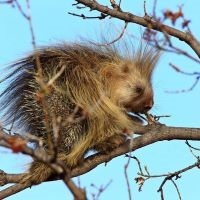 |
Porcupine
Porcupines are classified into two distinct groups – Old World, that inhabit Italy, Asia and Africa, and New World, living in North and South America.
Old World porcupines are large, and nocturnal, with quills that form clusters; they forage on the ground and can swim, whereas New World are smaller, can climb (some spend their lives in trees), and emerge during the day, and whose spines grow singly. A porcupine can have over 30,000 quills, if lost, new quills grow to replace old ones. Quills are sharp bristles made of fused hair that normally lie flat against the porcupine’s body.
Porcupines are solitary and territorial herbivores, with a keen sense of smell but poor vision. They move slowly and are generally docile, but if threatened, will stamp their feet, clatter their teeth, raising and shaking their quills. They also emit a foul odour, fooling some aggressors into thinking they are a skunk as quill raising exposes a white stripe along their backs. If all this fails, they charge sideways or backwards and swipe at the threat with their tail, which can be up to 10 inches long. Quills have barbs on them which are difficult to remove once embedded in flesh and can cause painful, sometimes deadly wounds. Babies, called porcupettes, are born with soft quills that harden soon after birth.
Most are classified as Least Concern, but the bristle-spined (living in Brazil), crested (N and W Africa) and Philippine porcupines are Vulnerable. Threats include loss of habitat, slow reproduction rates, climate change, some hunting and human interference: in Kenya and the Philippines, porcupines are regarded as pests that eat farm crops. They are eaten in S E Asia. Road kills also account for deaths as porcupines like salt and seek out areas where rock salt has been used to melt ice and snow, specifically roads.
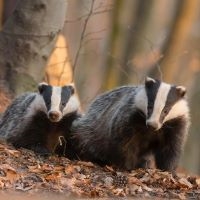 |
Badgers
The killing of badgers, euphemistically called ‘culling’, could carry on into 2025, although after this year, no new licenses are to be issued and vaccination of cattle and badgers will be relied on instead. Under 2020 mass badger culling licences, almost 38,500 were killed, bringing about a total death toll since 2013 of just under 141,000, with more to be killed under the supplementary licenses issued in 2022. The whole exercise has cost £70,000,000.
Badgers are killed under licence as part of a strategy to control bovine tuberculosis in England. This disease affects cows. It has been said that poor welfare conditions of cows, their cramped housing, lax biosecurity, and unreliable tests all add to the disease spreading. Instead of this being dealt with, the blame is heaped on badgers.
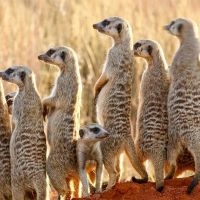 |
Meerkat
Meerkats are members of the mongoose family and live in dry desert regions at the southernmost tip of Africa. They live in social family groups, called mobs, of up to 30 members led by a dominant breeding male and female. All members take turns to forage for food, look out for predators, or stay behind to take care of the young. Although highly co-operative within their own group, they are highly competitive and aggressive with rival mobs.
Meerkats are omnivores, even being able to eat scorpions. They cannot store body fat, so must constantly hunt for food during the daytime. Whilst out foraging, sentries climb to the highest available point to keep watch for dangers. Meerkats have fantastic eyesight and can spot a predatory bird miles away on the horizon, the black markings round their eyes cut down the sun’s glare. At a warning chirp, members flee to nearby bolt holes, but if they are unexpectedly threatened and unable to escape, they stand together with arched backs and hiss loudly. Fantastic diggers, meerkats excavate several home burrows with many chambers and multiple entrances and exits; they can close their ears and draw a protective membrane over their eyes when digging.
Classified as ‘Of Least Concern’, the main threats to meerkats are predation and climate change.
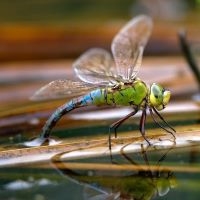 |
Dragonfly
There are at least 3,000 species of dragonfly worldwide, except in Antarctica. 57 different types live in the UK. One of the first winged species to evolve, dragonfly ancestry dates back 30,000,000 years ago, one now extinct dragonfly had a 30 inch wingspan.
With a lifecycle in 3 stages, after emerging from an egg, the dragonfly spends around 2 years in the water as a nymph, or larva, feeding. It has a hinged jaw with serrated teeth that shoots out to catch its prey. It finally crawls on to dry land, and the exoskeleton cracks open to release its abdomen, then its four wings to become an adult, which will live only a short time, normally just a few weeks.
Dragonflies are carnivorous, and eat other insects, including mosquitos. They are very effective hunters with a 95% success rate. With large compound eyes giving them nearly 360 degree vision, 80% of their brain is used to process visual information. They can move each of their 4 wings independently, fly and swerve in any direction, even up and down, and hover like a helicopter. They catch their prey in mid air and even mate on the wing. Larger species can reach a maximum flight speed of up to 34 mph and some swarm and migrate.
Threats include loss of habitat, climate change and pollution. Some species in the rainforests are in danger of becoming extinct before even being properly identified.
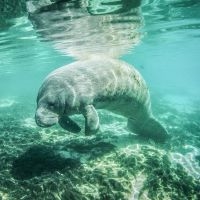 |
Manatee
Manatees are large, aquatic, herbivorous marine animals sometimes known as sea cows. They inhabit coastal areas and rivers of the Gulf of Mexico, the Amazon basin, the Caribbean Sea, and West Africa. They pootle around, at around 3-5 miles an hour and are very tranquil. They spend 50% of the day sleeping, but have to eat at least 15% of their body weight daily.
Manatees share a common ancestory with the elephant, aardvark, and hyrax, yet they never leave the water. They surface for air every 5 minutes, although if in a resting state, they can hold their breath underwater for up to 20 minutes.
Sadly, these beautiful creatures are classified as Vulnerable to Extinction. The University of Miami has found that millions of gallons of water laced with fertiliser ingredients started leaking into Tampa Bay in 2021 from an abandoned phosphate plant. This had led to dangerous levels of algae blooms that suffocate seagrass beds and kill marine life. In 2021 Florida was the deadliest year on record for manatee deaths from starvation. Large populations of manatees are drawn to the warm waters near to the Tampa Power Plant. They do not store blubber, so cold conditions adversely affect their immune systems; they cuddle together to keep warm.
Seagrass meadows also once spanned nearly 80,000 acres in the Indian river lagoon of Florida, where they serve as a cornerstone of one the country’s most biodiverse estuaries. Seagrass has been uprooted and destroyed by the many boat propellers that are allowed in the water. Collisions with boat propellers also maim or kill manatees, as does entanglement in fishing nets.
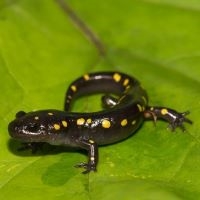 |
Spotted salamander
Spotted salamanders are amphibians found in Canada and Eastern USA. Forest dwellers living near water, they are active at night, concealing themselves under rocks, logs and leaf debris by day. They have sticky tongues that help them catch worms, insects, slugs, spiders, and millepedes. Special glands on their backs and tails secrete a vile tasting toxin that deters predators such as skunks, raccoons, turtles and snakes.
Emerging from a kind of dormancy akin to hibernation in spring, thousands make their way to the same ponds each year to mate. Females lay up to 200 eggs, coated in protective jelly. The young emerge as larvae with strong tails, weak legs and feathery gills on the outside of their body, and must stay in the water to survive. They prey on the larvae of beetles and mosquitos. After about 90 days, they lose their gills, their legs become stronger and they come onto land. Life expectancy is about 20 years.
Classified as Least Concern, threats include habitat destruction, particularly of their breeding grounds, and being run over as they cross roads to get to them.
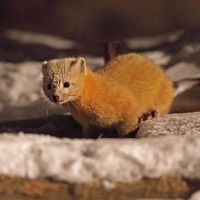 |
Sable
The sable has the ‘distinction’ of having the most luxurious of fur, being silky, dense and retaining smoothness in whichever direction it is stroked. Although colour varies by region, it can be almost black. Henry VIII decreed that sable could only be worn by nobles ranked higher than Viscount.
Part of the family that includes mink, otter, badger, wolverine and weasel, the sable is a genetic cousin to the pine marten, and found in the forests of Russia, Mongolia, Siberia and N. Asia. Secretive (the photo is of a mink in Japan, we couldn’t find a Russian one), solitary and mainly terrestrial, it has an individual territory of up to 30 square km. But it ranges further when prey is scarce, and also stores food in its den, which is constructed around tree roots and carpeted with grass and fur it has shed, for this eventuality. Sable have a keen sense of smell and hearing, communicating and marking territories via scent glands.
It had been overhunted in European forests by the 15th and 16th centuries, so traders turned to Russia and Siberia. Furs were traded for goods such as precious metals and firearms, and by the early 19th century, sable numbers were severely reduced due to extensive hunting. Approximately 19,000 animals were reintroduced into the wild in the mid 20th century. It is not known how many there are now, although today, the sable is classified as of ‘Least Concern’. In Russia, they are protected on state nature reserves, however, licenses to hunt are still issued. Sable are now bred and killed for fur on farms in Russia and Finland, and the argument to allow controlled hunting goes that fur farming has enabled wild populations to grow!
As well as the fur trade, threats include habitat loss through tree felling, and development of new mines, gas and oil fields.
